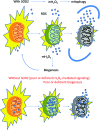Mitochondrial Superoxide Dismutase: What the Established, the Intriguing, and the Novel Reveal About a Key Cellular Redox Switch
- PMID: 31968997
- PMCID: PMC7047081
- DOI: 10.1089/ars.2019.7962
Mitochondrial Superoxide Dismutase: What the Established, the Intriguing, and the Novel Reveal About a Key Cellular Redox Switch
Abstract
Significance: Reactive oxygen species (ROS) are now widely recognized as central mediators of cell signaling. Mitochondria are major sources of ROS. Recent Advances: It is now clear that mitochondrial ROS are essential to activate responses to cellular microenvironmental stressors. Mediators of these responses reside in large part in the cytosol. Critical Issues: The primary form of ROS produced by mitochondria is the superoxide radical anion. As a charged radical anion, superoxide is restricted in its capacity to diffuse and convey redox messages outside of mitochondria. In addition, superoxide is a reductant and not particularly efficient at oxidizing targets. Because there are many opportunities for superoxide to be neutralized in mitochondria, it is not completely clear how redox cues generated in mitochondria are converted into diffusible signals that produce transient oxidative modifications in the cytosol or nucleus. Future Directions: To efficiently intervene at the level of cellular redox signaling, it seems that understanding how the generation of superoxide radicals in mitochondria is coupled with the propagation of redox messages is essential. We propose that mitochondrial superoxide dismutase (SOD2) is a major system converting diffusion-restricted superoxide radicals derived from the electron transport chain into highly diffusible hydrogen peroxide (H2O2). This enables the coupling of metabolic changes resulting in increased superoxide to the production of H2O2, a diffusible secondary messenger. As such, to determine whether there are other systems coupling metabolic changes to redox messaging in mitochondria as well as how these systems are regulated is essential.
Keywords: H2O2; MnSOD; SOD2; redox signaling.
Figures





Similar articles
-
Manganese superoxide dismutase (SOD2): is there a center in the universe of mitochondrial redox signaling?J Bioenerg Biomembr. 2017 Aug;49(4):325-333. doi: 10.1007/s10863-017-9718-8. Epub 2017 Jun 14. J Bioenerg Biomembr. 2017. PMID: 28616679 Review.
-
Manganese superoxide dismutase and glutathione peroxidase-1 contribute to the rise and fall of mitochondrial reactive oxygen species which drive oncogenesis.Biochim Biophys Acta Bioenerg. 2017 Aug;1858(8):628-632. doi: 10.1016/j.bbabio.2017.01.006. Epub 2017 Jan 11. Biochim Biophys Acta Bioenerg. 2017. PMID: 28087256 Free PMC article. Review.
-
Riding the tiger - physiological and pathological effects of superoxide and hydrogen peroxide generated in the mitochondrial matrix.Crit Rev Biochem Mol Biol. 2020 Dec;55(6):592-661. doi: 10.1080/10409238.2020.1828258. Epub 2020 Nov 4. Crit Rev Biochem Mol Biol. 2020. PMID: 33148057 Review.
-
Mitochondrial superoxide dismutase--signals of distinction.Anticancer Agents Med Chem. 2011 Feb;11(2):181-90. doi: 10.2174/187152011795255920. Anticancer Agents Med Chem. 2011. PMID: 21355846 Free PMC article. Review.
-
Redox Regulation of the Superoxide Dismutases SOD3 and SOD2 in the Pulmonary Circulation.Adv Exp Med Biol. 2017;967:57-70. doi: 10.1007/978-3-319-63245-2_5. Adv Exp Med Biol. 2017. PMID: 29047081
Cited by
-
Revealing the atomic and electronic mechanism of human manganese superoxide dismutase product inhibition.Nat Commun. 2024 Jul 16;15(1):5973. doi: 10.1038/s41467-024-50260-w. Nat Commun. 2024. PMID: 39013847 Free PMC article.
-
The Antitumor Potential of Sicilian Grape Pomace Extract: A Balance between ROS-Mediated Autophagy and Apoptosis.Biomolecules. 2024 Sep 3;14(9):1111. doi: 10.3390/biom14091111. Biomolecules. 2024. PMID: 39334877 Free PMC article.
-
Mitochondrial iron-sulfur clusters: Structure, function, and an emerging role in vascular biology.Redox Biol. 2021 Nov;47:102164. doi: 10.1016/j.redox.2021.102164. Epub 2021 Oct 12. Redox Biol. 2021. PMID: 34656823 Free PMC article. Review.
-
From imbalance to impairment: the central role of reactive oxygen species in oxidative stress-induced disorders and therapeutic exploration.Front Pharmacol. 2023 Oct 18;14:1269581. doi: 10.3389/fphar.2023.1269581. eCollection 2023. Front Pharmacol. 2023. PMID: 37927596 Free PMC article. Review.
-
Elderly rats fed with a high-fat high-sucrose diet developed sex-dependent metabolic syndrome regardless of long-term metformin and liraglutide treatment.Front Endocrinol (Lausanne). 2023 Oct 20;14:1181064. doi: 10.3389/fendo.2023.1181064. eCollection 2023. Front Endocrinol (Lausanne). 2023. PMID: 37929025 Free PMC article.
References
-
- Almeida A, Moncada S, and Bolanos JP. Nitric oxide switches on glycolysis through the AMP protein kinase and 6-phosphofructo-2-kinase pathway. Nat Cell Biol 6: 45–51, 2004 - PubMed
-
- Anderson RF. The reactions of oxygen and superoxide ions with flavosemiquinone radicals. In: Oxygen and Oxy-Radicals in Chemistry and Biology, edited by Rodgers MAJ, and Powers EL. New York, NY: Academic Press; pp. 597–600, 1981
-
- Asada K, Takahashi MA, Tanaka K, and Nakando Y. Formation of active oxygen and its fate in chloroplast. In: Biochemical and Medical Aspects of Active Oxygen, edited by Hayaishi O and Asada K. Baltimore, MD: University Park Press, 1977, pp. 45–63
Publication types
MeSH terms
Substances
Grants and funding
LinkOut - more resources
Full Text Sources
Research Materials

